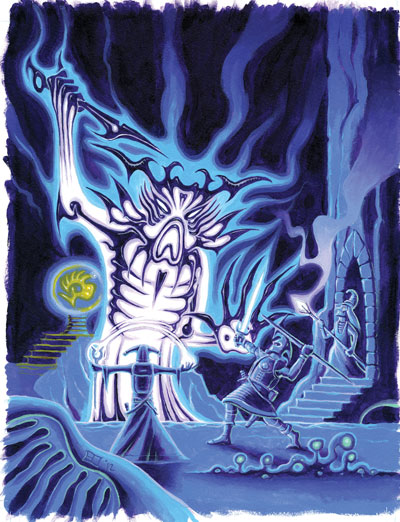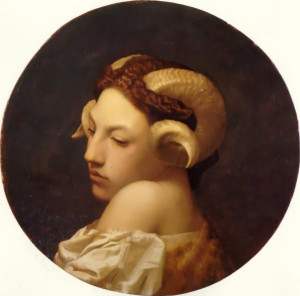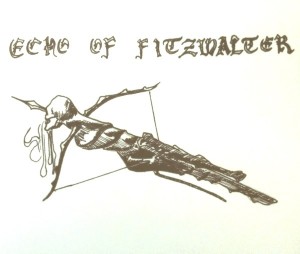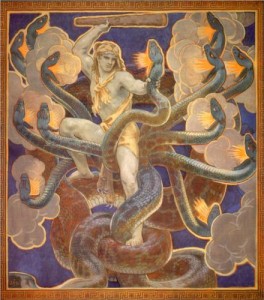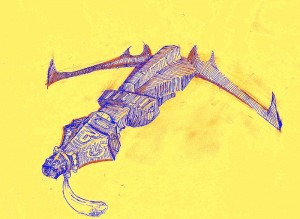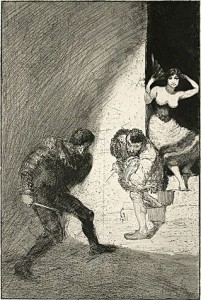
Max Klinger, Rivals (source)
Recently, when compiling a document of Finchbox classes, I noticed that, especially after basic house-rule adjustments, the assassin and thief classes seemed awfully similar. Both had d6 HD, light armor skill, backstab, low attack bonus, and a (slightly different) collection of skills. The only significant contrast was that assassins had disguise and poison-craft whereas thieves had the troubleshooting skills (search, find/remove traps, open locks, etc).
This is not enough to justify two separate classes for me, so the choice is to either reformulate the assassin or drop it. Another approach, I suppose, would be to replace both classes with something like the LotFP specialist, which can be customized, but I already know I don’t want to do that. For these rules, I prefer to have more focused, atmospheric classes. And I do want to keep the assassin as an option. So here is a modified S&W assassin, focused more on the ideal of single-shot kills (compared to the opportunism and utility that comprises the essence of the thief). Both classes still have backstab, but the increased martial focus of this assassin, along with the added poison-craft subsystem (described below), and lack of dungeon utility skills, distinguish the two classes. Max level in this game is 10.
The poison-craft description is still somewhat wordy, and I hope to tighten it up in the future, but for now this should be good enough to communicate the rules. I, of course, reserve the right to modify the poison rules if they don’t satisfy me in play. More poison recipes will be added later to bring the total above 10, so that high-level assassins don’t converge in poison knowledge.
Edit: added PDF version.
Assassin
- Hit die and weapon damage: d8
- Starting saving throw: 15
- Armor training: medium
- Attack bonus: medium
Special abilities & restrictions:
- Backstab: +4 to attack from surprise, +HD damage (5th: +2HD, 9th: +3HD)
- Poison recipes, one per level (odd: random, even: pick)
- Ambusher: a party with an assassin is more likely to surprise enemies (usually, 4 in 6)
- Skills: disguise, poison-craft, stealth (as thief of same level)
- Optional: vow of guild loyalty and guild connections
Poison-Craft
A flask of poison may be concocted as a downtime action for 100 SP. Applying poison to a weapon requires a poison kit (which is a significant item), an exploration turn, and a poison-craft check to see if the poison is used up. Each time the assassin hits with a poisoned weapon, another poison-craft check should be made to see if the poison application has worn off. In any case, a poison application will not last longer than a single excursion. Poison may also be extracted from a poisonous slain creature with a successful poison-craft check (this requires a downtime action, but doesn’t involve any expense). Any number of poisons may be carried in a poison kit without consuming further encumbrance slots.
Poisons:
- Affliction: +1d6 damage
- Anticoagulant: if further wounded, takes 1d6 bleed damage per round (save ends)
- Blindness: target is struck blind (new save allowed 1/day)
- Debilitation: -2 physical penalty, +1 damage from any attacks
- Delirium: unable to focus, hallucinations, actions have random targets
- Doom: death after one exploration turn
- Mage-bane: unable to cast spells (new save allowed 1/day)
- Paralysis: unable to move (new save allowed 1/exploration turn)
- Sleep: slumber for 8 hours (new save allowed if damaged)
- Suggestion: groggy, will obey general commands (charisma check needed)
All poisons allow a save to avoid the effect, and generally work only on living creatures approximately human-sized or less. Effects on other creatures are by referee ruling.

